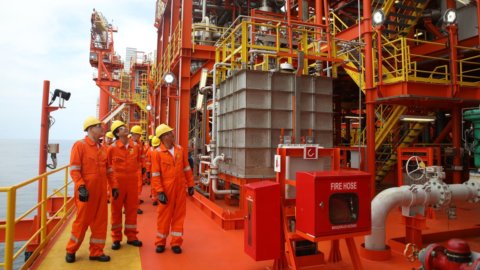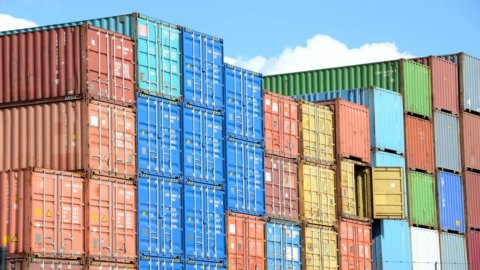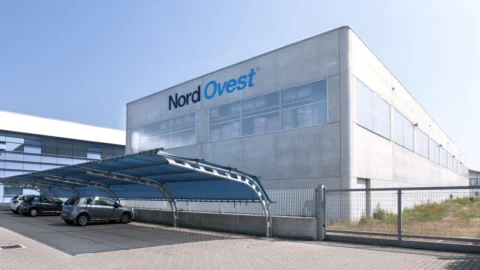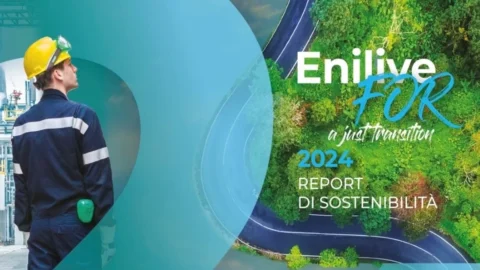All’estremo nord dell’Angola, dove il fiume Congo si apre sull’Oceano Atlantico, c’è una cittadina che si chiama Soyo. Le caravelle portoghesi erano arrivate qui alla fine del ‘400, l’avevano scelta come proprio avamposto e l’avevano battezzata Sonho – sogno, in italiano. E sorvolando la costa tra Luanda e Soyo si ha proprio l’impressione di sognare: spiagge infinite di sabbia bianca e densa foresta verde, esattamente lo stesso paesaggio che il navigatore Diogo Cão ha visto nel 1482.
Oggi Soyo è una cittadina in piena crescita: al largo della sua costa, ingenti scoperte petrolifere le assicurano l’importante ruolo di supporto logistico per gli operatori angolani e internazionali. A 60 km da qui, in mare aperto e in acque profonde, nel blocco 15/06, Eni ha scoperto 450 milioni di barili di petrolio. Un relinquishment che altri avevano esplorato senza esito e che Eni ha saputo trasformare in un successo esplorativo, portato in produzione in soli 3 anni: “Un record mondiale in termini di tempi, di velocità, di prestazioni”, spiega l’AD di Eni, Claudio Descalzi. “È la prima concretizzazione di un modello completamente nuovo che ci ha portato a essere i primi nell’esplorazione e adesso anche nello sviluppo. Abbiamo fatto una esplorazione molto aggressiva a cui in parallelo abbiamo affiancato lo sviluppo e l’avvio della progettazione. Mentre trovavamo il petrolio stavamo già avviando lo sviluppo, mentre facevamo l’esplorazione stavamo già mettendo in produzione i campi, e mentre i campi entravano in produzione continuavamo a fare l’esplorazione near field per futuri sviluppi. Così abbiamo ridotto i tempi e il capitale inattivo, e così abbiamo anticipato sia lo start-up che il cash flow.”
Il blocco 15/06 comprende diversi campi: quelli del West Hub sono entrati in produzione nel 2014 con la FPSO N’Goma. La produzione dell’East Hub è partita a febbraio 2017, con l’arrivo da Singapore della FPSO Olombendo: la nave che produce, tratta, immagazzina e distribuisce il petrolio ed è un record anche lei, per dimensioni, capacità, complessità e rapidità di costruzione. “La progettazione della Olombendo ha richiesto 16 mesi di lavoro, più di un milione di ore di ingegneria”, racconta Luca Faccenda, FPSO Work Package Manager di Eni Angola, da 10 anni nel gruppo. “Oltre 500 ingegneri sono stati coinvolti sui vari package, cioè sulle diverse componenti della nave, e nei momenti di picco in cantiere c’erano anche 4000 persone al lavoro”.
La particolarità di questa FPSO è una imponente torretta – la cantilever turret – integrata nella prua della nave, che permette alla FPSO di ruotare su se stessa adattando la posizione della nave alle correnti marine, senza però spostare le catene che ancorano la nave né i risers flessibili da cui passano olio e gas. “Si tratta della torretta esterna più grande, alta e pesante mai realizzata”, spiega ancora Luca Faccenda. “E’ alta 65 metri, pesa 5000 tonnellate. È tra i sistemi più importanti perché qui arrivano i fluidi di produzione che vengono trasferiti dal sistema subsea ai sistemi di trattamento di superficie, ma è anche la parte più stressata a livello strutturale perché assorbe e trasmetti i carichi alle catene e al suolo”.
La torretta è uno degli elementi di maggior complessità ingegneristica ed è stata anche uno dei punti in cui procedure e fattore umano, calcolo e lavoro di squadra si sono integrati con maggior efficacia nel modo tutto Eni di lavorare. Racconta Luca: “a un certo punto ho temuto che non avremmo potuto rispettare la tabella di marcia. Eravamo di fronte ad una scelta molto difficile riguardante l’assegnazione del contratto della torretta a causa della complessità del progetto. Il main contractor stava lavorando bene sul resto della nave ma non aveva esperienza specifica di progettazione di torrette di quelle dimensioni. Potevamo cercare un altro contractor ma questo avrebbe impattato sui tempi del progetto. Alla fine, col supporto del top management, abbiamo deciso di andare avanti col main contractor, supportandolo da vicino, ed è andata molto bene: proprio perché era la prima volta che realizzavano una torretta di tale complessità e dimensione, hanno dedicato ancora più cura al progetto. Abbiamo dato fiducia, ci abbiamo messo attenzione, e i risultati ci hanno ripagato”.
Fiducia, supporto, gioco di squadra, responsabilità sono parole ricorrenti quando si cerca di capire come fa Eni a raggiungere i suoi record. “The strength of the team is each individual member. The strength of each member is the team” è il motto di Valentin Talamba, Quality Assurance and Quality Control Manager di West Hub e East Hub, da 22 anni in Eni. Perché dietro a un blocco formato da più giacimenti, operato con due diverse FPSO e che produrrà fino a 150mila barili al giorno c’è la competenza tecnica, la capacità di analisi dei dati, la capacità di progettazione, di esecuzione, di operazione, di controllo. E poi ci sono le persone, c’è la motivazione, la leadership. “Una azienda non è fatta dai suoi mezzi tecnici, quelli si comprano e si vendono. Una azienda è fatta dalle sue persone”, spiega Valentin. “La differenza la fanno le persone. Cosa frena le persone? La paura. Cosa motiva le persone? La soddisfazione, e una leadership coinvolta. Come si crea una squadra? Ascoltando. Cercando di capire e di consigliare. Su questo progetto ho visto una capacità di teamwork a livelli che non avevo ancora visto, sia tra i colleghi, sia con i partner, sia con i fornitori. Abbiamo lavorato come un unico team, con un unico obiettivo: superare le aspettative. Dei vertici, ma anche le nostre”.
L’AD conferma questa lettura: “In Angola abbiamo un gruppo tecnici giovani molto motivati, e molto contenti di quello che stanno facendo, perché sentono di essere i primi” osserva Descalzi. “Siamo i primi in Angola nell’esplorazione e nello sviluppo, abbiamo avuto solo grandissimi successi. Inoltre la Olombendo è eccezionale dal punto di vista tecnologico”. Qui come ovunque, Eni opera per assicurare zero flaring, zero discharge e zero oil spills. “La Olombendo è studiata per durare, studiata per il futuro”, conclude Descalzi, “e permetterà all’Angola di avere una crescita produttiva che darà un contributo eccezionale allo sviluppo del Paese”.
Jenifer Nzoanene, Junior Process Engineer, da 3 anni in Eni, ha lavorato al processo di separazione e trattamento del crude che avviene a bordo della Olombendo: la nave infatti è attrezzata per reiniettare in giacimento l’acqua e il gas associati. “In questo modo uniamo efficienza e rispetto dell’ambiente”, spiega agli ospiti in visita alla FPSO. È giovane, brillante, entusiasta ed ha una motivazione incrollabile: “Potrei andare a lavorare all’estero. È una tentazione. Ma voglio fare la mia parte, dare il mio contributo alla crescita del mio paese. Ho potuto studiare all’estero e quello che ho imparato è un plusvalore. Io ora voglio essere parte del cambiamento dell’Angola”.
L’articolo è tratto da Eniday.





